A
Auto Express
Guest
The medium-sized Vauxhall Vivaro van has been for sale as part of the Vauxhall van line-up since the start of the 21st Century. It has been a popular choice for buyers, especially because it's Made In Britain: a fact that Vauxhall is proud to promote using badges on the van itself. For the third-generation model launched in 2019, the Vivaro was given a radical revamp.
Previous versions of the Vivaro have been the product of a joint venture with Renault, and as a result, it has shared much with the Renault Trafic mid-size van (as well as the similar parts-sharing Nissan NV300 and Fiat Talento). But with Vauxhall's acquisition by the PSA Group in 2017, the third generation Vivaro has seen wholesale changes. The van now shares its bodyshell and mechanicals with the Citroen Dispatch and Peugeot Expert, not to mention the fourth model in the line-up, the Toyota Proace.
• Best medium-sized panel vans to buy
One important factor to note is that the Vivaro is still Made In Britain - the Luton factory where the last model was built had a multi-million-pound refit so that manufacturing could continue uninterrupted at the site. Here the Vivaro is built in two lengths, L1 and L2, although unlike the old Vivaro, the L2's extra length is behind the rear axle, so both versions have the same wheelbase. The Vivaro is no longer available with a high-roof option, but the five-seater Vivaro Doublecab continues. This has a second row of seats and it's available in the same L1 and L2 lengths as the panel van. Finally, Vauxhall also offers a Vivaro Chassis Cab that's designed to be fitted out by conversion companies.
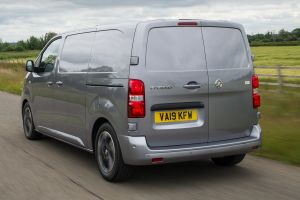
Vauxhall Vivaro van - rear tracking
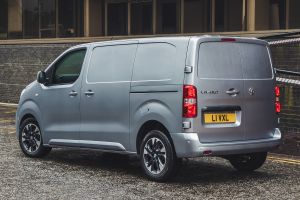
Vauxhall Vivaro van - rear static

Vauxhall Vivaro van - interior

Vauxhall Vivaro van - front tracking
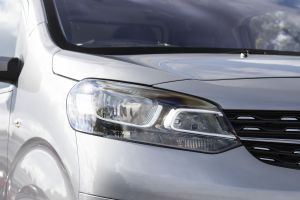
Vauxhall Vivaro van - headlight
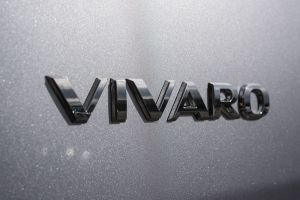
Vauxhall Vivaro van - badge

Vauxhall Vivaro van - front static
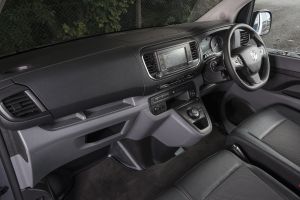
Vauxhall Vivaro van - interior

Vauxhall Vivaro van - badge
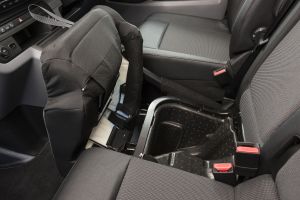
Vauxhall Vivaro van - seat storage
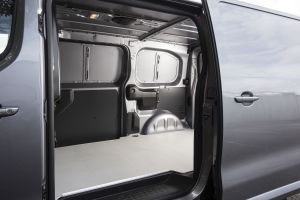
Vauxhall Vivaro van - side door
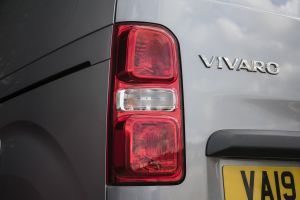
Vauxhall Vivaro van - rearlight
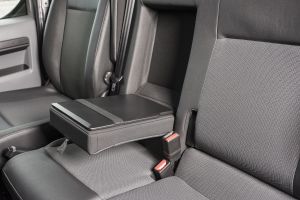
Vauxhall Vivaro van - armrest

Vauxhall Vivaro van - loading bay
Overall, the third-generation Vivaro is shorter and narrower than the old model and there's slightly less width between the wheelarches, but load volumes are slightly bigger than before, thanks to a slightly higher roof and less intrusion from said wheelarches. Vauxhall also offers a through-load facility for the standard-fit steel bulkhead that allows you to load long, narrow items all the way into the passenger side footwell. Payloads are improved, too.
Power comes from a choice of two diesel engines or there's an electric Vivaro-e now available, too. The diesels are a 1.5 Turbo D that comes in 100PS and 120PS outputs, while the 2.0 Turbo D is offered in 120PS, 150PS and 180PS guises. All vans are front-wheel drive with a 6-speed manual gearbox, although there the option of an 8-speed auto with selected 120PS models, while the 180PS motor has the auto box as standard. All vans get a 70-litre fuel tank, while a 22.5-litre AdBlue tank will need filling every few thousand miles. It's also worth noting that the more powerful 2.0 Turbo D engines aren't offered in the most basic versions of the Vivaro.
Go for the all-electric Vivaro-e, and you get a 136bhp electric motor and direct drive to the front wheels. Vauxhall offers two battery options at 50kWh and 75kWh, which have claimed ranges of 144 and 205 miles respectively. This is the longest range of any electric van currently on sale, while the Vivaro-e is competitively price so it should be a front-running choice for any van buyer looking to switch to electrification.
The Vivaro range comprises Edition, Dynamic, Sportive and Elite trims, while Vauxhall's naming structure sees every version of the Vivaro get a number that reflects its gross vehicle weight. All Vivaros now come with twin sliding side doors, driver and passenger airbags and cruise control, while a DAB radio with Bluetooth, separate cab and load area locking, electric windows, 12 Volt and USB connections are all included.
Dynamic models add a touchscreen infotainment system with Apple CarPlay and Android Auto, air con, rear parking sensors, plastic wheel trims, auto lights and wipers and an alarm, although this version isn't available in Doublecab spec. Go for Sportive if you want a FlexCargo through loading bulkhead, body coloured bumpers and LED daytime running lights.
At the top of the range, the Limited is aimed at small and medium enterprises (SMEs) and the self-employed. It adds luxuries such as alloy wheels, sat-nav, front and rear parking sensors, and Vauxhall's suite of safety kit, including lane assist, adaptive cruise control and blind spot alert, among others. Go for the Vivaro-e only comes in Dynamic and Limited trims.
Overall, the Vauxhall Vivaro is a user-friendly package that should appeal to medium-sized van buyers who want something that's car-like to drive. It should be available with more competitive finance deals than its Peugeot, Citroen and Toyota counterparts. As well as these rivals, the Vivaro faces competition from the Trafic/Talento/NV300 trio, plus the VW T6 Transporter and front-running Ford Transit Custom. But it’s certainly worth a place on any van buyer's shortlist.
The Vivaro's switch to PSA-developed engines is a boost for fuel economy as well as performance. The two diesel engines offered are 1.5 and 2.0-litre Turbo D diesels, while the all-electric Vivaro-e offers super-low running costs.
The 1.5 Turbo D comes in 100PS and 120PS forms with 99bhp/270Nm and 118bhp/300Nm respectively. The 2.0 Turbo D is also offered in 120PS from, as well as 150PS and 180PS guises, the latter with an auto gearbox as standard (all other vans have a 6-speed manual, while the 120PS diesel can be had with the auto box, too). The 120PS has 118bhp but has more torque, at 340Nm, while the other two engines are 148bhp/370Nm and 178bhp/400Nm. All engines come with stop-start.
Under the latest WLTP tests, the best-performing engine in the range for economy is the 1.5 120PS, which returns 60.1mpg on the combined test cycle. The 100PS version isn't far behind at 57.6mpg, while the 2.0 120PS has a best economy figure of 52.3mpg.

Vauxhall Vivaro van - rear tracking

Vauxhall Vivaro van - rear static

Vauxhall Vivaro van - interior

Vauxhall Vivaro van - front tracking

Vauxhall Vivaro van - headlight

Vauxhall Vivaro van - badge

Vauxhall Vivaro van - front static

Vauxhall Vivaro van - interior

Vauxhall Vivaro van - badge

Vauxhall Vivaro van - seat storage

Vauxhall Vivaro van - side door

Vauxhall Vivaro van - rearlight

Vauxhall Vivaro van - armrest

Vauxhall Vivaro van - loading bay
Go for a 2.0 150PS (which is only available in the L2 body length), and the best economy recorded under WLTP conditions is 52.3mpg. The auto-equipped 180PS engine manages 50.4mpg.
All Vivaros come with a 70-litre fuel tank, so you could theoretically travel more than 600 miles in any version on a single fill. There's also a 22.5-litre AdBlue tank that will need filling every few thousand miles. This is critical to the van's emissions, and the van's trip computer will let you know when it needs doing - ignore it and eventually the van won't start.
Service intervals for the Vivaro depend on which engine you choose. Go for a 1.5 Turbo D, and you'll need to visit your Vauxhall Business Centre every 2 years or 25,000 miles, whichever comes first. The 2.0 Turbo D models also have a two-year service interval, but the mileage limit is raised to 30,000 miles.
Most vans evolve from one model to the next, but with a wholesale switch in platform and running gear for the Vauxhall Vivaro, there are drastic changes to the panel van's cargo area.
There are L1 and L2 lengths like before, but while the last Vivaro had a longer wheelbase to increase cargo volume, the Vivaro Mk3 has extended bodywork behind the rear axle. At 4,959mm, the Vivaro L1 is 39mm shorter than before, while the L2 is 89mm shorter, at 5,309mm. That means the L2 is 350mm longer than the L1, compared to a 400mm difference between the old Vivaro L1 and L2.
Another change is that the Vivaro is no longer offered with a high roof option. The standard van is slightly taller than before, but that's no compensation for buyers wanting significant extra height - they'll need to look elsewhere, at the Ford Transit Custom, for example, or the Renault Trafic, if they liked the old Vivaro's dimensions. The larger Movano is the only option within Vauxhall's van range.

Vauxhall Vivaro van - rear tracking

Vauxhall Vivaro van - rear static

Vauxhall Vivaro van - interior

Vauxhall Vivaro van - front tracking

Vauxhall Vivaro van - headlight

Vauxhall Vivaro van - badge

Vauxhall Vivaro van - front static

Vauxhall Vivaro van - interior

Vauxhall Vivaro van - badge

Vauxhall Vivaro van - seat storage

Vauxhall Vivaro van - side door

Vauxhall Vivaro van - rearlight

Vauxhall Vivaro van - armrest

Vauxhall Vivaro van - loading bay
The Vivaro Mk3 is shorter and narrower than the Mk2, but most of the loss in length is found at the front, with a shorter bonnet before you get to the cab. The load area is a little shorter (2,512mm for the L1, 2,862mm for the L2, compared to 2,537mm and 2,937mm for the old Vivaro), and there's less width between the wheelarches, although it's only shrunk by a centimetre to 1.26 metres.
What the Vivaro has gained is a taller load area, with a maximum height of 1,397mm from floor to ceiling. That's a centimetre more than before, and when combined with less wheelarch intrusion into the load area, cargo capacity is slightly larger than the last Vivaro. That means a minimum load volume of 5.3 cubic metres for the L1, and 6.1 cubic metres for the L2. This expands to 5.8 and 6.6 cubic metres when the through-load facility is used, but this only applies to loads that can fit through the hole in the bulkhead, which will be planks, ladders, tubing or pipework.
In comparison, the Ford Transit Custom has up to 6.8 cubic metres of space without adding a through-load option, and there's a high-roof variant with up to 8.3 cubic metres of space.
There's a broader spread of payload weights than before for the Vivaro. The least powerful 100PS model can only take on 975kg, while the 120PS manages 1,079kg. Both 1.5 Turbo D engines are poorer than the old 1.6 CDTi in that regard. The 2.0 Turbo D is better, because it's able to carry up to 1,458kg in 120PS and 150PS guises, or up to 1,418kg in the 180PS auto. This is around 200kg more than the last Vivaro and shows the benefit of the torquier 2.0-litre diesel.
While load volumes and payload weights are good, access to the Vivaro's load space is a bit of a sticking point. The van's exterior design means the rear isn't as upright and square as before, and the back door openings are 100mm shorter at 1,220mm, while the overall width of the rear opening is down by 109mm to 1,282mm. The side doors are slightly less tall at 1,241mm, but are a significant 95mm narrower than before, at 935mm. This might be a major sticking point for potential buyers, although at least twin side doors are standard across the range.
Go for the Vivaro-e and all the same points about the diesel van's dimensions apply, because the electrical running gear doesn't have an impact on cargo volume. Payload weights range from 987kg for the Doublecab, then from 1,000-1,226kg for the panel van.
The switch to PSA Group running gear means the Vauxhall Vivaro is now one of the safest medium-sized vans for sale. It uses running gear that's similar to that of the Peugeot 3008 SUV and Citroen C4 SpaceTourer, so it comes fitted with advanced safety kit such as lane departure warning, adaptive cruise control and autonomous emergency braking.
However, most of this advanced safety kit only comes as standard on the top-spec Vivaro Elite - you have to pay extra to get it on the other versions. All vans do come with electronic stability and traction control with hill-start assist, driver and passenger airbags and cruise control with speed limiter, while Doublecab models add curtain airbags.

Vauxhall Vivaro van - rear tracking

Vauxhall Vivaro van - rear static

Vauxhall Vivaro van - interior

Vauxhall Vivaro van - front tracking

Vauxhall Vivaro van - headlight

Vauxhall Vivaro van - badge

Vauxhall Vivaro van - front static

Vauxhall Vivaro van - interior

Vauxhall Vivaro van - badge

Vauxhall Vivaro van - seat storage

Vauxhall Vivaro van - side door

Vauxhall Vivaro van - rearlight

Vauxhall Vivaro van - armrest

Vauxhall Vivaro van - loading bay
One issue we do have with the Vivaro is the lack of wide-angle mirrors. The old van used to have a second smaller mirror below the main ones to boost rear visibility, but that's no longer the case - and sometimes this could be just as effective as having blind spot detection instead. At least front and rear parking sensors and a reversing camera are all available.
In the unfortunate event that you do have an accident, the Vivaro's crash structure has already earned a five-star Euro NCAP rating. That's because the Citroen SpaceTourer (which is the MPV version of the Citroen Dispatch van) was tested in 2015, where it earned an 87% score for adult occupant protection, 64% for pedestrian protection and 78% for its safety assist functions.
And the good news continues in terms of the latest Vivaro's reliability. Again, its use of PSA Group running gear means that while it's a fresh new model for Vauxhall, all of its running gear and components have been used elsewhere within the PSA Group.
The body, chassis, suspension, engines and electronics are all shared with the Citroen Dispatch and Peugeot Expert, and these two models have been for sale in the UK since 2016 without much issue.
The parts sharing continues with the Vivaro-e. As well as electric Dispatch and Expert variants, the three vans share running gear with other electric models such as the Peugeot 2008, Vauxhall Corsa-e and DS 3 Crossback e-Tense.
There's a choice of 1.5 or 2.0-litre BlueHDi diesels, and unless you don't carry many weighty items in the back of your van, we'd recommend the 2.0-litre over the 1.5. The 1.5 is good for economy, but you'll likely have to work it harder with a heavy load on board, which will cancel out any fuel saving benefits it might provide.
The 2.0 BlueHDi comes in 150 and 180 guises, which have 148bhp and 178bhp respectively, while the latter also features an 8-speed auto gearbox. Both versions have good torque delivery and are responsive, and they help the Vivaro to cope with heavier payloads than the last model.

Vauxhall Vivaro van - rear tracking

Vauxhall Vivaro van - rear static

Vauxhall Vivaro van - interior

Vauxhall Vivaro van - front tracking

Vauxhall Vivaro van - headlight

Vauxhall Vivaro van - badge

Vauxhall Vivaro van - front static

Vauxhall Vivaro van - interior

Vauxhall Vivaro van - badge

Vauxhall Vivaro van - seat storage

Vauxhall Vivaro van - side door

Vauxhall Vivaro van - rearlight

Vauxhall Vivaro van - armrest

Vauxhall Vivaro van - loading bay
The 6-speed manual gearbox has a bit of a rubbery shift about it, which could become frustrating in regular use. It changes gear easily enough, but there's a sponginess to the lever that disappoints. If you're doing big mileages, and can afford the extra, we'd choose the 8-speed auto. It's a smooth gearbox that takes the strain out of driving.
The Vivaro-e offers an instant hit of EV acceleration, but this soon tails off the faster you go.
The Vivaro has a slightly lower driving position than before, while the van's responses are more car-like. The steering reacts quickly to inputs, and with a lower centre of gravity it feels more nimble when unladen.
Of course the suspension is designed with heavy payloads in mind, and there's good stability with a half-load on board. When unladen, there's some suspension bounce, but it's not as harsh as some rival vans in the class.
Refinement is good, and the Vivaro is quiet at higher speeds - we just wish the door mirrors were larger so you could have a better feel for your surroundings.
If you're trading in your old Vauxhall Vivaro for the current one, you'll immediately notice the lower seating position from behind the wheel. Thanks to its new running gear, the driving position is very car-like. It's still taller than most SUVs, but doesn't quite have the same commanding position that the old Vivaro did.

Vauxhall Vivaro van - rear tracking

Vauxhall Vivaro van - rear static

Vauxhall Vivaro van - interior

Vauxhall Vivaro van - front tracking

Vauxhall Vivaro van - headlight

Vauxhall Vivaro van - badge

Vauxhall Vivaro van - front static

Vauxhall Vivaro van - interior

Vauxhall Vivaro van - badge

Vauxhall Vivaro van - seat storage

Vauxhall Vivaro van - side door

Vauxhall Vivaro van - rearlight

Vauxhall Vivaro van - armrest

Vauxhall Vivaro van - loading bay
However, there's plenty of seat and wheel adjustment, so it's easy to get comfortable, and the seats themselves are reasonably supportive, although they might feel a little soft for some. One niggle is that while the driver gets a left armrest, there isn't one on the right, while the window ledge and door trim aren't in a position to let you rest your elbow, making the driving position feel a little awkward.
The seats themselves are trimmed in easy-clean fabric, while all vans get a pair of passenger seats. However, if you are regularly travelling three-up, you might want to look elsewhere, because the Vivaro isn't the most comfortable three-seat van on the market - the last version was more comfortable for three-abreast seating, with more shoulder room and a wider passenger seat base.
The Vivaro's dashboard is identical to the one you'll find in the Citroen Dispatch or Peugeot Expert. That means most functions are on the central touchscreen, although the climate controls are separate, unlike on some other PSA models. Build quality is fine, with hard wearing plastics that feel robust and solid, while storage is useful, too.
The middle passenger seat folds down to create a table, while the seat bases open to reveal under-floor storage, although this is also where loads come through if you're using the hatch in the bulkhead. The glovebox is on the small side, courtesy of the position of the fuse box next to it, but there's dashtop storage and deep door bins, too.
Continue reading...
Previous versions of the Vivaro have been the product of a joint venture with Renault, and as a result, it has shared much with the Renault Trafic mid-size van (as well as the similar parts-sharing Nissan NV300 and Fiat Talento). But with Vauxhall's acquisition by the PSA Group in 2017, the third generation Vivaro has seen wholesale changes. The van now shares its bodyshell and mechanicals with the Citroen Dispatch and Peugeot Expert, not to mention the fourth model in the line-up, the Toyota Proace.
• Best medium-sized panel vans to buy
One important factor to note is that the Vivaro is still Made In Britain - the Luton factory where the last model was built had a multi-million-pound refit so that manufacturing could continue uninterrupted at the site. Here the Vivaro is built in two lengths, L1 and L2, although unlike the old Vivaro, the L2's extra length is behind the rear axle, so both versions have the same wheelbase. The Vivaro is no longer available with a high-roof option, but the five-seater Vivaro Doublecab continues. This has a second row of seats and it's available in the same L1 and L2 lengths as the panel van. Finally, Vauxhall also offers a Vivaro Chassis Cab that's designed to be fitted out by conversion companies.

Vauxhall Vivaro van - rear tracking

Vauxhall Vivaro van - rear static

Vauxhall Vivaro van - interior

Vauxhall Vivaro van - front tracking

Vauxhall Vivaro van - headlight

Vauxhall Vivaro van - badge

Vauxhall Vivaro van - front static

Vauxhall Vivaro van - interior

Vauxhall Vivaro van - badge

Vauxhall Vivaro van - seat storage

Vauxhall Vivaro van - side door

Vauxhall Vivaro van - rearlight

Vauxhall Vivaro van - armrest

Vauxhall Vivaro van - loading bay
Overall, the third-generation Vivaro is shorter and narrower than the old model and there's slightly less width between the wheelarches, but load volumes are slightly bigger than before, thanks to a slightly higher roof and less intrusion from said wheelarches. Vauxhall also offers a through-load facility for the standard-fit steel bulkhead that allows you to load long, narrow items all the way into the passenger side footwell. Payloads are improved, too.
Power comes from a choice of two diesel engines or there's an electric Vivaro-e now available, too. The diesels are a 1.5 Turbo D that comes in 100PS and 120PS outputs, while the 2.0 Turbo D is offered in 120PS, 150PS and 180PS guises. All vans are front-wheel drive with a 6-speed manual gearbox, although there the option of an 8-speed auto with selected 120PS models, while the 180PS motor has the auto box as standard. All vans get a 70-litre fuel tank, while a 22.5-litre AdBlue tank will need filling every few thousand miles. It's also worth noting that the more powerful 2.0 Turbo D engines aren't offered in the most basic versions of the Vivaro.
Go for the all-electric Vivaro-e, and you get a 136bhp electric motor and direct drive to the front wheels. Vauxhall offers two battery options at 50kWh and 75kWh, which have claimed ranges of 144 and 205 miles respectively. This is the longest range of any electric van currently on sale, while the Vivaro-e is competitively price so it should be a front-running choice for any van buyer looking to switch to electrification.
The Vivaro range comprises Edition, Dynamic, Sportive and Elite trims, while Vauxhall's naming structure sees every version of the Vivaro get a number that reflects its gross vehicle weight. All Vivaros now come with twin sliding side doors, driver and passenger airbags and cruise control, while a DAB radio with Bluetooth, separate cab and load area locking, electric windows, 12 Volt and USB connections are all included.
Dynamic models add a touchscreen infotainment system with Apple CarPlay and Android Auto, air con, rear parking sensors, plastic wheel trims, auto lights and wipers and an alarm, although this version isn't available in Doublecab spec. Go for Sportive if you want a FlexCargo through loading bulkhead, body coloured bumpers and LED daytime running lights.
At the top of the range, the Limited is aimed at small and medium enterprises (SMEs) and the self-employed. It adds luxuries such as alloy wheels, sat-nav, front and rear parking sensors, and Vauxhall's suite of safety kit, including lane assist, adaptive cruise control and blind spot alert, among others. Go for the Vivaro-e only comes in Dynamic and Limited trims.
Overall, the Vauxhall Vivaro is a user-friendly package that should appeal to medium-sized van buyers who want something that's car-like to drive. It should be available with more competitive finance deals than its Peugeot, Citroen and Toyota counterparts. As well as these rivals, the Vivaro faces competition from the Trafic/Talento/NV300 trio, plus the VW T6 Transporter and front-running Ford Transit Custom. But it’s certainly worth a place on any van buyer's shortlist.
The Vivaro's switch to PSA-developed engines is a boost for fuel economy as well as performance. The two diesel engines offered are 1.5 and 2.0-litre Turbo D diesels, while the all-electric Vivaro-e offers super-low running costs.
The 1.5 Turbo D comes in 100PS and 120PS forms with 99bhp/270Nm and 118bhp/300Nm respectively. The 2.0 Turbo D is also offered in 120PS from, as well as 150PS and 180PS guises, the latter with an auto gearbox as standard (all other vans have a 6-speed manual, while the 120PS diesel can be had with the auto box, too). The 120PS has 118bhp but has more torque, at 340Nm, while the other two engines are 148bhp/370Nm and 178bhp/400Nm. All engines come with stop-start.
Under the latest WLTP tests, the best-performing engine in the range for economy is the 1.5 120PS, which returns 60.1mpg on the combined test cycle. The 100PS version isn't far behind at 57.6mpg, while the 2.0 120PS has a best economy figure of 52.3mpg.

Vauxhall Vivaro van - rear tracking

Vauxhall Vivaro van - rear static

Vauxhall Vivaro van - interior

Vauxhall Vivaro van - front tracking

Vauxhall Vivaro van - headlight

Vauxhall Vivaro van - badge

Vauxhall Vivaro van - front static

Vauxhall Vivaro van - interior

Vauxhall Vivaro van - badge

Vauxhall Vivaro van - seat storage

Vauxhall Vivaro van - side door

Vauxhall Vivaro van - rearlight

Vauxhall Vivaro van - armrest

Vauxhall Vivaro van - loading bay
Go for a 2.0 150PS (which is only available in the L2 body length), and the best economy recorded under WLTP conditions is 52.3mpg. The auto-equipped 180PS engine manages 50.4mpg.
All Vivaros come with a 70-litre fuel tank, so you could theoretically travel more than 600 miles in any version on a single fill. There's also a 22.5-litre AdBlue tank that will need filling every few thousand miles. This is critical to the van's emissions, and the van's trip computer will let you know when it needs doing - ignore it and eventually the van won't start.
Service intervals for the Vivaro depend on which engine you choose. Go for a 1.5 Turbo D, and you'll need to visit your Vauxhall Business Centre every 2 years or 25,000 miles, whichever comes first. The 2.0 Turbo D models also have a two-year service interval, but the mileage limit is raised to 30,000 miles.
Most vans evolve from one model to the next, but with a wholesale switch in platform and running gear for the Vauxhall Vivaro, there are drastic changes to the panel van's cargo area.
There are L1 and L2 lengths like before, but while the last Vivaro had a longer wheelbase to increase cargo volume, the Vivaro Mk3 has extended bodywork behind the rear axle. At 4,959mm, the Vivaro L1 is 39mm shorter than before, while the L2 is 89mm shorter, at 5,309mm. That means the L2 is 350mm longer than the L1, compared to a 400mm difference between the old Vivaro L1 and L2.
Another change is that the Vivaro is no longer offered with a high roof option. The standard van is slightly taller than before, but that's no compensation for buyers wanting significant extra height - they'll need to look elsewhere, at the Ford Transit Custom, for example, or the Renault Trafic, if they liked the old Vivaro's dimensions. The larger Movano is the only option within Vauxhall's van range.

Vauxhall Vivaro van - rear tracking

Vauxhall Vivaro van - rear static

Vauxhall Vivaro van - interior

Vauxhall Vivaro van - front tracking

Vauxhall Vivaro van - headlight

Vauxhall Vivaro van - badge

Vauxhall Vivaro van - front static

Vauxhall Vivaro van - interior

Vauxhall Vivaro van - badge

Vauxhall Vivaro van - seat storage

Vauxhall Vivaro van - side door

Vauxhall Vivaro van - rearlight

Vauxhall Vivaro van - armrest

Vauxhall Vivaro van - loading bay
The Vivaro Mk3 is shorter and narrower than the Mk2, but most of the loss in length is found at the front, with a shorter bonnet before you get to the cab. The load area is a little shorter (2,512mm for the L1, 2,862mm for the L2, compared to 2,537mm and 2,937mm for the old Vivaro), and there's less width between the wheelarches, although it's only shrunk by a centimetre to 1.26 metres.
What the Vivaro has gained is a taller load area, with a maximum height of 1,397mm from floor to ceiling. That's a centimetre more than before, and when combined with less wheelarch intrusion into the load area, cargo capacity is slightly larger than the last Vivaro. That means a minimum load volume of 5.3 cubic metres for the L1, and 6.1 cubic metres for the L2. This expands to 5.8 and 6.6 cubic metres when the through-load facility is used, but this only applies to loads that can fit through the hole in the bulkhead, which will be planks, ladders, tubing or pipework.
In comparison, the Ford Transit Custom has up to 6.8 cubic metres of space without adding a through-load option, and there's a high-roof variant with up to 8.3 cubic metres of space.
There's a broader spread of payload weights than before for the Vivaro. The least powerful 100PS model can only take on 975kg, while the 120PS manages 1,079kg. Both 1.5 Turbo D engines are poorer than the old 1.6 CDTi in that regard. The 2.0 Turbo D is better, because it's able to carry up to 1,458kg in 120PS and 150PS guises, or up to 1,418kg in the 180PS auto. This is around 200kg more than the last Vivaro and shows the benefit of the torquier 2.0-litre diesel.
While load volumes and payload weights are good, access to the Vivaro's load space is a bit of a sticking point. The van's exterior design means the rear isn't as upright and square as before, and the back door openings are 100mm shorter at 1,220mm, while the overall width of the rear opening is down by 109mm to 1,282mm. The side doors are slightly less tall at 1,241mm, but are a significant 95mm narrower than before, at 935mm. This might be a major sticking point for potential buyers, although at least twin side doors are standard across the range.
Go for the Vivaro-e and all the same points about the diesel van's dimensions apply, because the electrical running gear doesn't have an impact on cargo volume. Payload weights range from 987kg for the Doublecab, then from 1,000-1,226kg for the panel van.
The switch to PSA Group running gear means the Vauxhall Vivaro is now one of the safest medium-sized vans for sale. It uses running gear that's similar to that of the Peugeot 3008 SUV and Citroen C4 SpaceTourer, so it comes fitted with advanced safety kit such as lane departure warning, adaptive cruise control and autonomous emergency braking.
However, most of this advanced safety kit only comes as standard on the top-spec Vivaro Elite - you have to pay extra to get it on the other versions. All vans do come with electronic stability and traction control with hill-start assist, driver and passenger airbags and cruise control with speed limiter, while Doublecab models add curtain airbags.

Vauxhall Vivaro van - rear tracking

Vauxhall Vivaro van - rear static

Vauxhall Vivaro van - interior

Vauxhall Vivaro van - front tracking

Vauxhall Vivaro van - headlight

Vauxhall Vivaro van - badge

Vauxhall Vivaro van - front static

Vauxhall Vivaro van - interior

Vauxhall Vivaro van - badge

Vauxhall Vivaro van - seat storage

Vauxhall Vivaro van - side door

Vauxhall Vivaro van - rearlight

Vauxhall Vivaro van - armrest

Vauxhall Vivaro van - loading bay
One issue we do have with the Vivaro is the lack of wide-angle mirrors. The old van used to have a second smaller mirror below the main ones to boost rear visibility, but that's no longer the case - and sometimes this could be just as effective as having blind spot detection instead. At least front and rear parking sensors and a reversing camera are all available.
In the unfortunate event that you do have an accident, the Vivaro's crash structure has already earned a five-star Euro NCAP rating. That's because the Citroen SpaceTourer (which is the MPV version of the Citroen Dispatch van) was tested in 2015, where it earned an 87% score for adult occupant protection, 64% for pedestrian protection and 78% for its safety assist functions.
And the good news continues in terms of the latest Vivaro's reliability. Again, its use of PSA Group running gear means that while it's a fresh new model for Vauxhall, all of its running gear and components have been used elsewhere within the PSA Group.
The body, chassis, suspension, engines and electronics are all shared with the Citroen Dispatch and Peugeot Expert, and these two models have been for sale in the UK since 2016 without much issue.
The parts sharing continues with the Vivaro-e. As well as electric Dispatch and Expert variants, the three vans share running gear with other electric models such as the Peugeot 2008, Vauxhall Corsa-e and DS 3 Crossback e-Tense.
There's a choice of 1.5 or 2.0-litre BlueHDi diesels, and unless you don't carry many weighty items in the back of your van, we'd recommend the 2.0-litre over the 1.5. The 1.5 is good for economy, but you'll likely have to work it harder with a heavy load on board, which will cancel out any fuel saving benefits it might provide.
The 2.0 BlueHDi comes in 150 and 180 guises, which have 148bhp and 178bhp respectively, while the latter also features an 8-speed auto gearbox. Both versions have good torque delivery and are responsive, and they help the Vivaro to cope with heavier payloads than the last model.

Vauxhall Vivaro van - rear tracking

Vauxhall Vivaro van - rear static

Vauxhall Vivaro van - interior

Vauxhall Vivaro van - front tracking

Vauxhall Vivaro van - headlight

Vauxhall Vivaro van - badge

Vauxhall Vivaro van - front static

Vauxhall Vivaro van - interior

Vauxhall Vivaro van - badge

Vauxhall Vivaro van - seat storage

Vauxhall Vivaro van - side door

Vauxhall Vivaro van - rearlight

Vauxhall Vivaro van - armrest

Vauxhall Vivaro van - loading bay
The 6-speed manual gearbox has a bit of a rubbery shift about it, which could become frustrating in regular use. It changes gear easily enough, but there's a sponginess to the lever that disappoints. If you're doing big mileages, and can afford the extra, we'd choose the 8-speed auto. It's a smooth gearbox that takes the strain out of driving.
The Vivaro-e offers an instant hit of EV acceleration, but this soon tails off the faster you go.
The Vivaro has a slightly lower driving position than before, while the van's responses are more car-like. The steering reacts quickly to inputs, and with a lower centre of gravity it feels more nimble when unladen.
Of course the suspension is designed with heavy payloads in mind, and there's good stability with a half-load on board. When unladen, there's some suspension bounce, but it's not as harsh as some rival vans in the class.
Refinement is good, and the Vivaro is quiet at higher speeds - we just wish the door mirrors were larger so you could have a better feel for your surroundings.
If you're trading in your old Vauxhall Vivaro for the current one, you'll immediately notice the lower seating position from behind the wheel. Thanks to its new running gear, the driving position is very car-like. It's still taller than most SUVs, but doesn't quite have the same commanding position that the old Vivaro did.

Vauxhall Vivaro van - rear tracking

Vauxhall Vivaro van - rear static

Vauxhall Vivaro van - interior

Vauxhall Vivaro van - front tracking

Vauxhall Vivaro van - headlight

Vauxhall Vivaro van - badge

Vauxhall Vivaro van - front static

Vauxhall Vivaro van - interior

Vauxhall Vivaro van - badge

Vauxhall Vivaro van - seat storage

Vauxhall Vivaro van - side door

Vauxhall Vivaro van - rearlight

Vauxhall Vivaro van - armrest

Vauxhall Vivaro van - loading bay
However, there's plenty of seat and wheel adjustment, so it's easy to get comfortable, and the seats themselves are reasonably supportive, although they might feel a little soft for some. One niggle is that while the driver gets a left armrest, there isn't one on the right, while the window ledge and door trim aren't in a position to let you rest your elbow, making the driving position feel a little awkward.
The seats themselves are trimmed in easy-clean fabric, while all vans get a pair of passenger seats. However, if you are regularly travelling three-up, you might want to look elsewhere, because the Vivaro isn't the most comfortable three-seat van on the market - the last version was more comfortable for three-abreast seating, with more shoulder room and a wider passenger seat base.
The Vivaro's dashboard is identical to the one you'll find in the Citroen Dispatch or Peugeot Expert. That means most functions are on the central touchscreen, although the climate controls are separate, unlike on some other PSA models. Build quality is fine, with hard wearing plastics that feel robust and solid, while storage is useful, too.
The middle passenger seat folds down to create a table, while the seat bases open to reveal under-floor storage, although this is also where loads come through if you're using the hatch in the bulkhead. The glovebox is on the small side, courtesy of the position of the fuse box next to it, but there's dashtop storage and deep door bins, too.
Continue reading...
